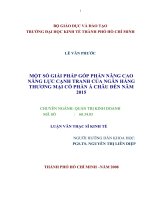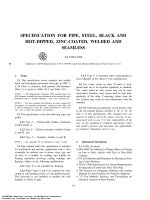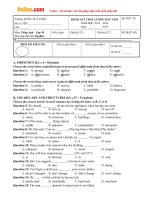Astm a 834 95 (2015)
Bạn đang xem bản rút gọn của tài liệu. Xem và tải ngay bản đầy đủ của tài liệu tại đây (94.31 KB, 4 trang )
Designation: A834 − 95 (Reapproved 2015)
Standard Specification for
Common Requirements for Iron Castings for General
Industrial Use1
This standard is issued under the fixed designation A834; the number immediately following the designation indicates the year of
original adoption or, in the case of revision, the year of last revision. A number in parentheses indicates the year of last reapproval. A
superscript epsilon (´) indicates an editorial change since the last revision or reapproval.
1. Scope
2. Referenced Documents
2.1 ASTM Standards:2
A47/A47M Specification for Ferritic Malleable Iron Castings
A48/A48M Specification for Gray Iron Castings
A197/A197M Specification for Cupola Malleable Iron
A220/A220M Specification for Pearlitic Malleable Iron
A247 Test Method for Evaluating the Microstructure of
Graphite in Iron Castings
A278/A278M Specification for Gray Iron Castings for
Pressure-Containing Parts for Temperatures Up to 650°F
(350°C)
A319 Specification for Gray Iron Castings for Elevated
Temperatures for Non-Pressure Containing Parts
A395/A395M Specification for Ferritic Ductile Iron
Pressure-Retaining Castings for Use at Elevated Temperatures
A436 Specification for Austenitic Gray Iron Castings
A439 Specification for Austenitic Ductile Iron Castings
A518/A518M Specification for Corrosion-Resistant HighSilicon Iron Castings
A532/A532M Specification for Abrasion-Resistant Cast
Irons
A536 Specification for Ductile Iron Castings
A571/A571M Specification for Austenitic Ductile Iron Castings for Pressure-Containing Parts Suitable for LowTemperature Service
A644 Terminology Relating to Iron Castings
A802/A802M Practice for Steel Castings, Surface Acceptance Standards, Visual Examination
A823 Specification for Statically Cast Permanent Mold Gray
Iron Castings
A842 Specification for Compacted Graphite Iron Castings
A874/A874M Specification for Ferritic Ductile Iron Castings Suitable for Low-Temperature Service
A897/A897M Specification for Austempered Ductile Iron
Castings
1.1 This specification covers a group of requirements that
are mandatory requirements when used in conjunction with the
following iron casting specifications issued by ASTM:
ASTM Specification2
A47/A47M
A48/A48M
A197/A197M
A220/A220M
A278/A278M
A319
A395/A395M
A436
A439
A518/A518M
A532/A532M
A536
A571/A571M
A823
A842
A874/A874M
A897/A897M
1.2 This specification also covers a group of supplementary
requirements which may be applied to the above specifications
as indicated herein. These are provided for use when additional
testing or inspection is desired and apply only when specified
individually by the purchaser in the order.
1.3 The requirements of the individual material
specification, and this general specification shall prevail in the
sequence named.
1.4 The values stated in inch-pound units are to be regarded
as standard. The values given in parentheses are mathematical
conversions to SI units that are provided for information only
and are not considered standard.
1
This specification is under the jurisdiction of ASTM Committee A04 on Iron
Castings and is the direct responsibility of Subcommittee A04.01 on Grey and White
Iron Castings.
Current edition approved Nov. 1, 2015. Published November 2015. Originally
approved in 1984. Last previous edition approved in 2011 as A834 – 95 (2011).
DOI: 10.1520/A0834-95R15.
2
For referenced ASTM standards, visit the ASTM website, www.astm.org, or
contact ASTM Customer Service at For Annual Book of ASTM
Standards volume information, refer to the standard’s Document Summary page on
the ASTM website.
Copyright © ASTM International, 100 Barr Harbor Drive, PO Box C700, West Conshohocken, PA 19428-2959. United States
1
A834 − 95 (2015)
Test Methods E30 and E351 may be used for chemical
analysis. In the event of a dispute regarding chemical
composition, Test Methods E351 and E30 shall be used for
referee purposes.
A919 Terminology Relating to Heat Treatment of Metals
(Withdrawn 1999)3
E8 Test Methods for Tension Testing of Metallic Materials
E10 Test Method for Brinell Hardness of Metallic Materials
E29 Practice for Using Significant Digits in Test Data to
Determine Conformance with Specifications
E30 Test Methods for Chemical Analysis of Steel, Cast Iron,
Open-Hearth Iron, and Wrought Iron (Withdrawn 1995)3
E59 Practice for Sampling Steel and Iron for Determination
of Chemical Composition (Withdrawn 1996)3
E94 Guide for Radiographic Examination
E165 Practice for Liquid Penetrant Examination for General
Industry
E351 Test Methods for Chemical Analysis of Cast Iron—All
Types
E689 Reference Radiographs for Ductile Iron Castings
E709 Guide for Magnetic Particle Testing
E802 Reference Radiographs for Gray Iron Castings Up to
41⁄2 in. (114 mm) in Thickness
2.2 Military Standard:
MIL-STD-129 Marking for Shipment and Storage4
2.3 Federal Standard:
Fed. Std. No. 123 Marking for Shipment (Civil Agencies)4
6.3 The chemical analysis for total carbon shall be made on
chilled pencil-type specimens or from thin wafers approximately 1⁄32 in. (0.8 mm) thick cut from test coupons. Drillings
are not reliable because of a probable loss of graphite.
6.4 Chemical analysis results shall be rounded, in accordance with Practice E29, to the nearest unit in the last
right-hand place of values in the table of chemical requirements.
6.5 A product analysis may be made by the purchaser from
material representing each heat, lot, or casting. The analysis
shall be made on representative material. Samples for carbon
analysis shall be taken no closer than ¼ in. to a cast surface,
and shall follow the practice in 5.3, except where the size or
shape of the casting does not permit such sampling. The
chemical composition thus determined shall meet the requirements specified in the applicable specification for the grade
involved.
7. Workmanship, Finish, and Appearance
3. Terminology
7.1 All castings shall be made in a workman-like manner
and shall conform to the dimensions on drawings furnished by
the purchaser before manufacture is started. If the pattern is
supplied by the purchaser, the dimensions of the casting shall
be as predicted by the pattern.
3.1 Definitions:
3.1.1 Definitions for many terms common to iron castings
and their heat treatment are found in Terminology A919 and
Terminology A644. A classification of graphite structure is
found in Test Method A247.
4. Ordering Information
8. Sampling
4.1 The purchase order for castings ordered under this
specification shall stipulate the applicable material
specification(s), grade of iron, and any options or additions to
the basic requirements, including the supplementary requirements included in this specification.
8.1 A lot shall consist of one of the following:
8.1.1 All the metal from a single heating in a batch–type
melting furnace.
8.1.2 All the metal poured from two or more batch–type
melting furnaces into a single ladle or a single casting.
8.1.3 All the metal poured from a continuous melting
furnace for a given period of time between changes in charge,
processing conditions, or aim-for chemistry, or 4 h, whichever
is the shorter period.
8.1.3.1 The purchaser may agree to extend the 4-h time
period to 8 h if the manufacturer can demonstrate sufficient
process control to warrant such an extension.
5. Tensile Requirements
5.1 The individual product specifications vary as to whether
tension tests are required. For this reason, and to determine
specific test requirements, the individual product specification
shall be reviewed. When required, tension tests shall be
determined in accordance with Test Methods E8.
6. Chemical Requirements
9. Inspection
6.1 The individual product specifications vary as to whether
chemical analysis is required. To determine specific
requirements, the individual product specification should be
reviewed.
9.1 All tests and inspections required by this specification
shall be performed by the manufacturer or other reliable
sources whose services have been contracted for by the
manufacturer. Complete records of all tests and inspections
shall be maintained by the manufacturer and shall be available
for review by the purchaser.
6.2 Sampling shall be conducted in accordance with Test
Method E59. Spectrographic or other methods such as those in
9.2 The manufacturer shall afford the purchaser’s inspector
all reasonable facilities necessary to satisfy that the material is
being produced and furnished in accordance with the applicable specification. Foundry inspection by the purchaser shall
not interfere unnecessarily with the manufacturer’s operations.
3
The last approved version of this historical standard is referenced on
www.astm.org.
4
Available from Standardization Documents Order Desk, DODSSP, Bldg. 4,
Section D, 700 Robbins Ave., Philadelphia, PA 19111-5098, http://
www.dodssp.daps.mil.
2
A834 − 95 (2015)
9.3 When agreed upon between manufacturer and
purchaser, test specimens or unbroken test bars from the same
lot shall be saved for a period of 3 months after date of the test
report.
be in accordance with the manufacturer’s commercial practice.
Packing and marking shall also be adequate to identify the
contents and to ensure acceptance and safe delivery by the
carrier for the mode of transportation employed.
9.4 When unbroken test bars are reprocessed with castings
for rehearing, test specimens from these bars shall be saved, as
described in 9.3.
12.2 Government Procurement—When specified in the contract or purchase order, marking for shipment shall be in
accordance with the requirements of Fed. Std. No. 123 for civil
agencies and MIL-STD-129 for military activities.
9.5 The purchaser reserves the right to perform any inspections set forth in the specification where such inspections are
deemed necessary to assure that supplies and services conform
to the prescribed requirements.
13. Quality Assurance
13.1 The surface of the casting shall be free of adhering
sand, scale, cracks, and hot tears as determined by visual
examination. Other surface discontinuities shall meet the visual
acceptance standards specified in the order. Visual Practice
A802/A802M or other visual standards may be used to define
acceptable surface discontinuities and finish. Unacceptable
visual surface discontinuities shall be removed and their
removal verified by visual examination of the resultant cavities.
10. Repair
10.1 Any repair shall be made in accordance with the
requirements of the individual specification using procedures
qualified by the manufacturer for the type of repair involved.
11. Rejection and Rehearing
11.1 Castings which fail to conform to the requirements
specified when inspected or tested by the purchaser or his agent
may be rejected. Rejection shall be reported to the manufacturer or supplier promptly and in writing. In case of dissatisfaction with the test results, the manufacturer or supplier may
make claim for a rehearing.
13.2 When additional inspection is desired, Supplementary
Requirements S1, S2, or S3 may be specified.
14. Keywords
14.1 chemical composition; common requirements; general industry; inspection; iron castings; ordering information;
packaging; quality assurance; repair; sampling; tensile requirements; terminology; workmanship
12. Packaging and Package Marking
12.1 Unless otherwise specified in the contract or purchase
order, cleaning, preservation, and packaging of castings shall
SUPPLEMENTARY REQUIREMENTS
Supplementary requirements shall be applied only when specified by the purchaser. Details of the
supplementary requirements shall be agreed upon by the manufacturer and purchaser. The specified
tests shall be performed by the manufacturer prior to shipment of the castings.
developing procedure, and basis for acceptance shall be agreed
upon between the manufacturer and purchaser.
S1. Magnetic Particle Examination
S1.1 Castings shall be examined for surface discontinuities
by magnetic particle examination. The examination shall be in
accordance with Practice E709. The extent of examination and
the basis for acceptance shall be agreed upon between the
manufacturer and purchaser.
S4. Certification
S4.1 The manufacturer’s certification shall be furnished to
the purchaser stating that the material was manufactured,
sampled, tested, and inspected in accordance with the material
specification, including the year date, and was found to meet
the requirements. Additionally, the certification shall include
for each lot the results of all tests required by the material
specification and any supplementary or additional requirements
imposed by the purchase order.
S4.2 A signature is not required on the certification or test
report. However, the document shall clearly identify the
organization submitting the certification and the authorized
agent of the manufacturer who certified the test results.
Notwithstanding the absence of a signature, the organization
submitting the certification is responsible for its content.
S4.3 The test report shall be furnished within 5 working
days of shipment of the castings.
S2. Radiographic Examination
S2.1 Castings shall be examined for internal defects by
means of X-rays or gamma rays. The procedure shall be in
accordance with Guide E94, and types and degrees of discontinuities considered shall be judged by Reference Radiographs
E689 and E802. The extent of examination and basis for
acceptance shall be agreed upon between the manufacturer and
purchaser.
S3. Liquid Penetrant Examination
S3.1 Castings shall be examined for surface discontinuities
by means of liquid penetrant examination. The examination
shall be in accordance with Practice E165. Areas to be
inspected, methods and types of liquid penetrants to be used,
3
A834 − 95 (2015)
S5. Prior Approval of Major Repairs
S5.1 Major repairs as defined and agreed upon between the
manufacturer and purchaser shall be subject to the prior
approval of the purchaser.
S6.2 When the castings are of such size that individual
marking is impracticable, they shall be grouped by part
identification or lot number and placed in a container. The
container shall be marked with the required identification.
S6. Marking
S7. Hardness Test
S6.1 The manufacturer’s name or identification mark and
the part identification number shall be cast or stamped on all
castings. When further specified, lot numbers shall be marked
on individual castings.
S7.1 Hardness measurements at specified locations on the
castings shall be made in accordance with Test Method E10
and reported.
ASTM International takes no position respecting the validity of any patent rights asserted in connection with any item mentioned
in this standard. Users of this standard are expressly advised that determination of the validity of any such patent rights, and the risk
of infringement of such rights, are entirely their own responsibility.
This standard is subject to revision at any time by the responsible technical committee and must be reviewed every five years and
if not revised, either reapproved or withdrawn. Your comments are invited either for revision of this standard or for additional standards
and should be addressed to ASTM International Headquarters. Your comments will receive careful consideration at a meeting of the
responsible technical committee, which you may attend. If you feel that your comments have not received a fair hearing you should
make your views known to the ASTM Committee on Standards, at the address shown below.
This standard is copyrighted by ASTM International, 100 Barr Harbor Drive, PO Box C700, West Conshohocken, PA 19428-2959,
United States. Individual reprints (single or multiple copies) of this standard may be obtained by contacting ASTM at the above
address or at 610-832-9585 (phone), 610-832-9555 (fax), or (e-mail); or through the ASTM website
(www.astm.org). Permission rights to photocopy the standard may also be secured from the Copyright Clearance Center, 222
Rosewood Drive, Danvers, MA 01923, Tel: (978) 646-2600; />
4









